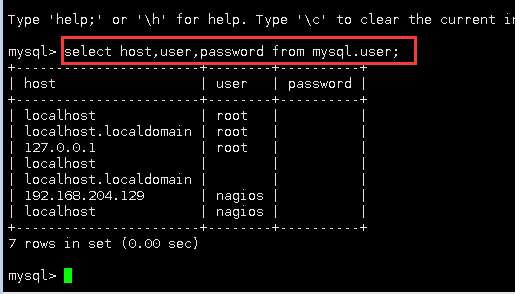mysql,开源,免费,好用,优点就不多说了。
在linux系统中,如centos6.5(我在此做实验,嘿嘿)yum 安装简单方便,一键解决依赖关系
# yum install mysql-server mysql -y
查看安装mysql,生成了那些文件
# rpm -ql mysql
默认主配置文件在/etc/my.cnf
查看mysql 是否启动
# ps -ef |grep mysql
然后,你就可以启动你的数据库了,
# /etc/init.d/mysqld start
# /etc/init.d/mysqld --help # 查看后面可以用的参数
默认mysql登录是没有密码的,命令行直接输入mysql即可:
标准的连接mysql语句如下:
# mysql -u root -h localhost -p

进入数据库查看mysql用户:
> select host,user,password from mysql.user; #数据库和 表中间用句点(.),命令写完用分号(;)

修改root密码: # 注意mysql 的root,不是linux系统的root
> update mysql.user set password=password("123456") where user="root" and host="localhost";
***password("123456") 表示调用password函数
删除匿名用户
> drop user ''@'localhost';
> drop user ""@"localhost.localdomain";
添加一个新用户,并赋权限;
格式:grant 权限 on 数据库.* to 用户名@登录主机 identified by "密码"

查看数据库:
> show databases;
> create database mynewdb;
> use mynewdb;
> show tables;
> create table newtable ( id int );
> show tables;
查看数据库字符集:
> show variables like 'character_set_database';
> show variables like "%char%"; # 百分号代表任意字符;
默认字符是Latin 为了避免以后乱码,你需要修改为utf-8,方法如下;
在/etc/my.cnf 对应的配置段加入如下相应命令:
[client] 段 加入 default-character-set=utf8
[mysqld] character-set-server=utf8
[mysql] default-character-set=utf8
然后重启mysql 服务即可

备份数据库
# mysqldump -uroot -p123123 数据库名称 > backdb.sql
恢复mysql 备份
# mysql -uroot -p12313 数据库名称 < backdb.sql
MySQL 忘记密码
# /etc/init.d/mysqld stop
# mysqld_safe --skip-grant-tables & #& 代表后台启动
# mysql # 进入数据库
mysql> update user set password=password("123456") where user="root";
# 修改完成,重启mysql
/etc/init.d/mysqld restart
慢慢总结,再总结,再总结